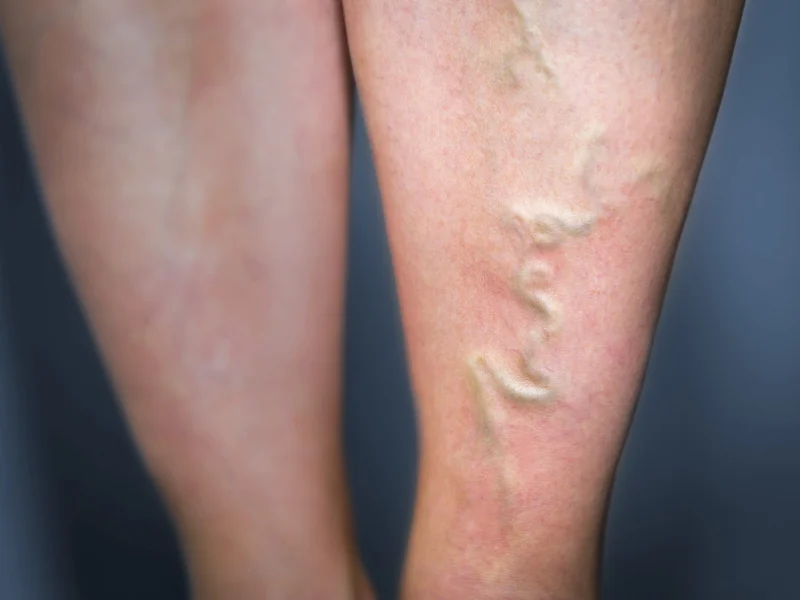What are the symptoms of superficial thrombophlebitis?
Superficial thrombophlebitis, also known as superficial vein thrombosis, is a condition characterized by inflammation and clot formation in a vein close to the surface of the skin. The symptoms typically include:
- Pain: Tenderness and pain along the affected vein, which can be sharp, aching, or throbbing. The pain may worsen with movement or palpation.
- Redness: Redness or discoloration of the skin over the affected vein. The area may appear inflamed or irritated.
- Swelling: Swelling or puffiness around the affected vein. The swelling is usually localized to the area of the vein.
- Warmth: The skin over the affected vein may feel warm to the touch compared to the surrounding areas.
- Hardness: A hard, cord-like structure may be palpable along the affected vein, which is the clot or thrombus.
- Itching or Sensitivity: Itching or increased sensitivity in the area of the inflammation.
- Visible Veins: In some cases, the affected vein may be visibly swollen or prominent under the skin.
These symptoms usually affect the veins of the legs but can occur in other areas where superficial veins are present. While superficial thrombophlebitis is generally less serious than deep vein thrombosis (DVT), it can still cause significant discomfort and requires appropriate management.
What are the causes of superficial thrombophlebitis?
Superficial thrombophlebitis can be caused by various factors, often related to conditions that affect blood flow or vein inflammation. Common causes include:
- Trauma or Injury: Physical injury to the vein, such as from an intravenous (IV) catheter or needle, can lead to irritation and clot formation.
- Varicose Veins: Individuals with varicose veins are at higher risk due to the increased pressure and altered blood flow in these veins, which can contribute to clot formation and inflammation.
- Prolonged Immobility: Extended periods of immobility, such as during long flights or bed rest, can contribute to poor circulation and increase the risk of thrombosis.
- Pregnancy: Hormonal changes and increased pressure on veins during pregnancy can predispose individuals to superficial thrombophlebitis.
- Infection: Infection or inflammation of the vein wall (phlebitis) can cause blood clots to form. This can occur with or without an associated superficial vein thrombosis.
- Venous Insufficiency: Conditions that affect the proper functioning of veins, such as chronic venous insufficiency, can increase the risk of thrombophlebitis.
- Hormonal Factors: Hormonal changes, such as those associated with oral contraceptives or hormone replacement therapy, can increase the risk of clot formation.
- Certain Medical Conditions: Conditions that affect blood clotting or increase the risk of clot formation, such as clotting disorders, can contribute to superficial thrombophlebitis.
- Injury or Surgery: Surgical procedures or injuries that involve veins can lead to inflammation and clot formation.
- Chronic Conditions: Conditions such as obesity or diabetes, which can affect blood circulation and increase the risk of vein inflammation and thrombosis.
Managing risk factors and addressing underlying conditions can help reduce the likelihood of developing superficial thrombophlebitis.
What is the treatment for superficial thrombophlebitis?
Treatment for superficial thrombophlebitis focuses on relieving symptoms, reducing inflammation, and preventing complications. The approach typically includes:
- Pain Management: Over-the-counter pain relievers, such as ibuprofen or acetaminophen, can help alleviate pain and reduce inflammation.
- Warm Compresses: Applying warm compresses or heating pads to the affected area can help reduce pain and inflammation.
- Elevation: Elevating the affected limb can help reduce swelling and improve blood flow.
- Compression: Using compression stockings can help support the veins and reduce swelling. They are particularly useful in cases related to varicose veins.
- Rest: Reducing activity and avoiding activities that exacerbate symptoms can aid in the healing process.
- Anticoagulants: In some cases, especially if there is a significant risk of progression to deep vein thrombosis (DVT), doctors may prescribe anticoagulants (blood thinners) to prevent further clotting.
- Treating Underlying Conditions: Addressing any underlying conditions that contribute to superficial thrombophlebitis, such as varicose veins or hormonal factors, can help manage and prevent future episodes.
- Anti-inflammatory Medications: In cases of significant inflammation, stronger anti-inflammatory medications may be prescribed by a healthcare provider.
- Surgical Intervention: In rare cases, if there are complications or if symptoms do not improve with conservative measures, surgical intervention may be necessary to remove the affected vein.
- Monitoring and Follow-up: Regular follow-up with a healthcare provider to monitor the condition and ensure that it is resolving appropriately is important.
Overall, the treatment plan is tailored to the severity of the symptoms, the underlying cause, and the individual’s overall health. Most cases of superficial thrombophlebitis resolve with conservative management.

Leave a Reply
You must be logged in to post a comment.